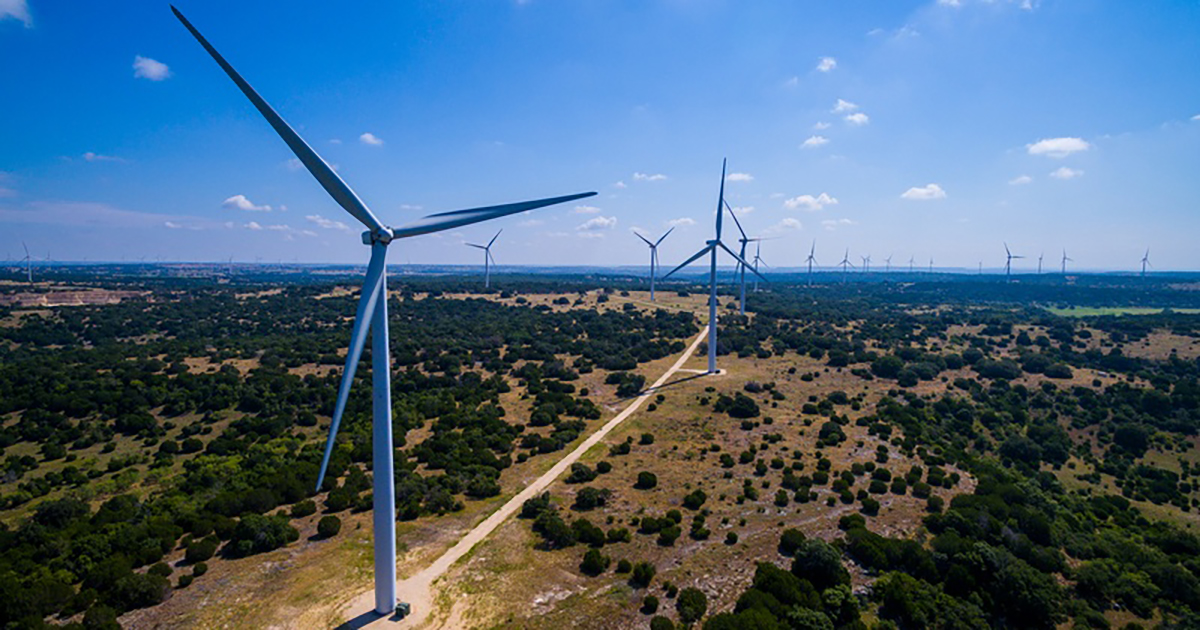Shifting clouds cast shadows over your office, reducing solar exposure to your building’s roof. A summer breeze halts midday, letting hot stagnant air build up as the wind stops blowing. An unexpected storm settles into the region, delaying staff from reaching job sites.
For renewable energy, these weather shifts and interruptions cause what is commonly referred to as intermittency, the sudden change in energy production. But intermittency isn’t only about fluctuations in solar and wind energy.
Sunshine or clouds will change your heating and cooling energy demands, altering residential and business load profiles for the entire day. Hot ambient air building up near a natural gas power plant will lower electricity output considerably, sometimes as much as 15-20% — correlating with the highest demands from air conditioning loads. Remote working policies and changes to business operating hours can also significantly affect demand and shift when those peaks occur.
And while, “That all sounds pretty tricky, but it’s the utility’s problem” is a perfectly reasonable response, being part of the solution is a significant opportunity for businesses looking to turn their utility bill into a reliable revenue stream.
looking at
Untapped Potential
The US electric grid connects millions of energy users across the continent and powers billions of devices, from phones to factories. Delivering energy ‘just in time’, electricity must be generated, sent across miles of wire at near the speed of light, and delivered to the customer in a matter of seconds.
To make things even more complex, up until recently there were not cost-effective ways to store large amounts of energy on demand and near a customer’s load. Every electron had to be created and consumed in real time (and 99% of the time, still does).
Everything connected to the grid has some amount of intermittency; moment-to-moment, day-to-day, season-to-season. And the system is constantly adapting in real-time to the ebbs and flows of ever-shifting electricity demands.
Likewise, every type of generation — solar panels, wind power, hydro dams, fossil fuel plants, and more — have sometimes variable outputs, failure rates, and operational limitations that must be planned for, accommodated, and priced into the system.
And add to all that a hub-and-spoke grid network where the connection between a power plant and customers can be severed by a tree branch falling or an animal making its way into a transformer or substation, and it becomes clear that all this fluctuation requires constant vigilance and adaptation.
A cloud passing over a solar panel may drop its output 10% or more, but one person out of town not taking a hot shower that day also lowers a home’s energy demands about 15%. A hotel fixing a bank of elevators would reduce and then increase the entire building’s large load 8-10% as they turn them off and on, based on the mechanic’s progress. A grocery store uses nearly 65% of its energy on refrigeration and lighting, and is receiving a fresh shipment, opening and closing air conditioned doors, and filling up empty freezers whenever the truck arrives.
The variability of a customer’s energy load— and the ability to vary it on cue — is the largest untapped resource available to us today to create a more flexible, responsive electric grid that can handle the increasingly dynamic demands of the future.
why
Frequency Matters
The one metric that most simply encapsulates the dynamic demands of the electric grid is frequency.
As noted, the grid operates in real-time.So whenever you flip a light switch on or off, somewhere on the grid a tiny shift must be made, either lowering demand from a different load or slightly ramping up output so that the delicate harmony of supply and demand can be maintained.
When those two forces are in perfect balance — you have one office building and the utility has one office building’s worth of power flowing — the frequency of the electric grid will hum along at exactly 60 hertz. If there is more demand and frequency drops, brownouts and total outages can ensue. If generation outpaces demand by too much, surges of electricity will ripple and damage power equipment and could reach all the way to homes and businesses.
Grid operators serve to balance the generation of electricity demands throughout their territory. These macro balancing efforts are supported by the transmission and distribution utilities who handle similar dynamics at the regional and local level, balancing themselves between available grid power and the individual customer loads served.
when
Everything Changes
On a macro level, all of these minute changes can be anticipated (an office typically ramps down when a restaurant is ramping up), weather forecasts give a reasonable estimation of system heating and cooling needs, and any dramatic changes are mostly smoothed out by interconnecting a variety of loads over a wide area.
But on a localized level, where we are rapidly transforming system demands with new technologies, increasingly dynamic supply and demand is causing new problems. Many of these new loads and technologies are not driven simply by the weather and typical office schedules, making them much more difficult for balancing authorities to predict and adapt to with the same tools they have used in the past.
For example, the rapid growth of electric vehicle charging brings with it new load profiles, as the need for changing is determined by a random individual’s driving habits, routine, and charger availability. And while EV’s may not be widespread today, consider a future scenario where dramatic transportation variability can beset the grid as tens of millions of electrified vehicles take to the streets.
XX
Clogged Central Arteries
Today’s EV batteries take nearly 3x the energy to fully charge than a typical household uses in a day. The Central Artery/Tunnel project (the ‘Big Dig’) in Boston sees up to 190,000 vehicles pass through it daily, fully electrified that’s the equivalent load of 570,000 houses on wheels.
Someone runs a red light or changes lanes too quickly causing traffic delays, and suddenly an electric load equivalent to a mid-sized city is driving around waiting to plug into the grid at tens of thousands of different outlets.
And even if traffic data was already integrated in utility modeling, a power plant with only about 125 MW and can serve the basic needs of 120,000 homes’ loads (without EV’s). This traffic jam could be a few minutes, it could be a few hours; but on an inflexible grid that could mean multiple power plants just idling and waiting for drivers to get home because someone had a bad day on the interstate.
The current drive to ‘electrify everything’, vehicles and beyond, as a way to save money and mitigate climate impacts puts all types of new demands on the grid. Oftentimes these technologies are also providing two-way power flows and giving energy back to the system, a recent phenomenon that our grid was not designed to handle.
And plugging new systems — like the needs of the modern transportation network and all of its dynamics — into aging grid infrastructure is poised to cause new disruptions and require new techniques and strategies to maintain constant system balance.
Up until the 1970’s, grid operators really only had one or two dials that they could turn to maintain grid balance, using system inertia and gently nudging behemoth power plant outputs to match tiny energy variations. At the end of that decade, utilities and the Department of Energy started experimenting with what we now call ‘demand response’ and other types of load control programs, along with price signals and revamped time of use rates, have since evolved and could be the key to future adaptation.
XX
Nature's Inexorable Imperative
As H.G. Wells coined it, ‘adapt or perish’. And utilities are quickly employing customers and their variable loads in centralized efforts to tame these new electricity demands, in addition to infrastructure upgrades and enhanced communications.
Controllable loads are available everywhere on the electricity network, we just need to teach them how to react and coordinate their ability to talk with one another to respond to the needs of the larger grid.
In New York state, which has a robust demand response marketplace, customers have allocated more than 1.3 GW’s of their load that can be turned off when grid operators need to meet peak capacity needs. That is a considerable amount of energy available to be reduced with the flip of a switch, more than the recently shuttered Indian Point nuclear reactor #2 and representing more than 4% of the highest summer system peak.
As just one example, during a notorious 2001 heatwave in NYC, demand response programs saved grid operators more than $13 million during peak demand hours in just a few days. Those savings are shared amongst everyone on the grid, and then part is used to compensate the businesses that were able reduce their load when it was needed most.
Grid operators often incentivize these actions in a few ways. First, demand response participants are compensated whenever they are called upon to reduce their load, creating a new revenue stream for the business. Utilities also have tariffs that reward customers who can avoid using energy during coincident peak times when the transmission and distribution system is most stressed.
These approaches — committed customer loads and voluntary price signals — enable businesses to monetize their flexibility. Varying demand to match the availability of electricity is much more efficient (don’t need to transmit anything) and cost-effective (less need for expensive ‘peaking’ power plants) than alternatives.
XX
Signaling Profits Ahead
Many of the components that would make up these energy solutions, like solar panels with energy storage, geothermal heating and cooling, and integrated inverters that can respond to grid signals are also eligible for different types of tax incentives and grant programs available from state and federal governments.
Many utilities offer additional incentive programs for businesses to install resilient energy technologies and efficiency solutions that can limit and control loads on-demand, enabling customer participation in creating a more flexible grid.
Taken in total, we are starting to engage dynamic demand and load control technologies and strategies that are critical to the future of the electric grid. Utilities, regulators, grid operators and other market participants are encouraging customers to become active in solving grid challenges.
Businesses should seriously consider how they can be a part of that solution, what questions to ask, and what incentives are available to support becoming a proactive consumer. Beyond just saving money, these programs are actively contributing to making the grid more reliable and effective for everyone.
We are tapping into the power of variable loads on the electric grid, rapidly electrifying everything around us, and turning what was once a negative — intermittency — into a tool to achieve our ambitious energy, resilience, and climate goals.
Participating in the interruptible load market requires a careful examination of your business operations and energy needs. That’s what Priority Power Management does. If you’re interested in looking more deeply into demand response programs for your business, we’re happy to help as your energy solutions expert. Give us a call!





